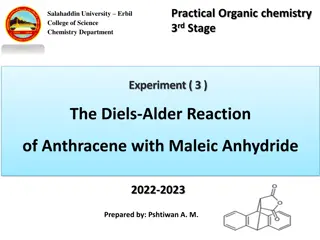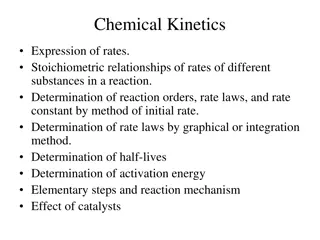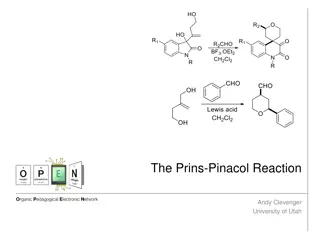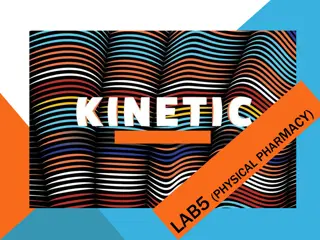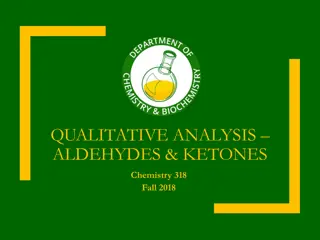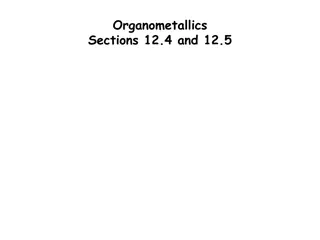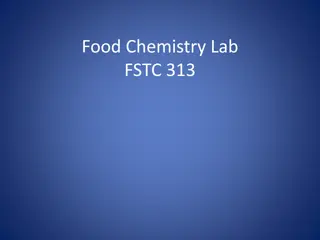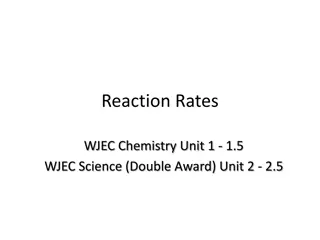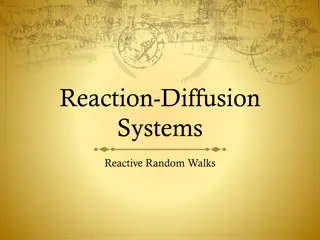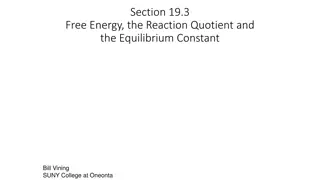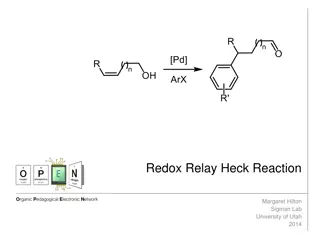Grignard Reaction in Chemistry Lab: Part 1 Overview
The Grignard Reaction Part 1 in Chemistry 318 Fall 2018 involves the preparation of the Grignard reagent, its reaction with CO2, and the isolation of the benzoic acid product. The experiment spans two lab sessions, focusing on safety precautions, pre-lab checks, and upcoming due dates. Students are reminded to follow specific guidelines for reports and utilize the provided resources for successful completion. Key aspects include reaction mechanisms, avoidance of acidic contaminants, and the potential for by-products. Experiments, reports, and deadlines are outlined, emphasizing attention to detail and accuracy.
Download Presentation

Please find below an Image/Link to download the presentation.
The content on the website is provided AS IS for your information and personal use only. It may not be sold, licensed, or shared on other websites without obtaining consent from the author.If you encounter any issues during the download, it is possible that the publisher has removed the file from their server.
You are allowed to download the files provided on this website for personal or commercial use, subject to the condition that they are used lawfully. All files are the property of their respective owners.
The content on the website is provided AS IS for your information and personal use only. It may not be sold, licensed, or shared on other websites without obtaining consent from the author.
E N D
Presentation Transcript
GRIGNARD REACTION PART 1 Chemistry 318 Fall 2018
Schedule of day PPE check at the door Pre-lab check at the door Quiz Recitation Grignard Reaction, part I Safety Put bags away Goggles Gloves Lab Coat LAB!
Due Dates Today: Beginning of lab Unknown Identification Report At the end of lab copy of laboratory notebook pages for today's experiment. Next Week: Spectra problem II. #5. A preliminary Separation Scheme for isolating and purifying benzoic acid from the Grignard reaction. The scheme should be written in your notebook. The scheme should also include written notes from the experimental procedure for next week. Be sure to use the guidance shown in the Figure in the Experiment linked to the syllabus page (identical to p. 118 in the Manual). DO NOT copy it exactly! This will constitute most of your notebook report grade for the week. Two Weeks: Grignard Reaction Report
Today Please look over your graded Friedel-Crafts report. Almost all errors are due to not reading the instructions for writing the report as given on Bb and in the Manual. You must write correct citations for chemical properties. See the Manual. Cite the source of your literature spectra. Pay attention to Reaction Classification . Friedel-Crafts is not a reaction classification; Electrophilic Aromatic Substitution is. Resonance contributors in mechanisms are important. Use molecular/structural formulas at least once in your Separation Scheme. Na2SO4 H2O
The Experiment This experiment takes two lab sessions Part I: Preparation of the Grignard reagent and its reaction with CO2 Part II: Isolation of the benzoic acid product Use the instructions that are linked to the CHEM 318 syllabus for both parts.
The Reaction Be sure to review your lecture text for more information on the Grignard reaction. Br Mg-Br ether Mg0 Organohalides react with magnesium metal by a free radical reaction to form an organomagnesium halide (Grignard reagent) The halogens are usually Br or Cl The organo group can be alkyl or aryl There cannot be any acidic groups present in the organohalide (such as OH, CO2H, C CH)
The Reaction Grignard reagents react with H2O (acidic) and O2 and so exposure to them must be avoided. O-O-Mg-Br O2 Mg-Br H H2O Grignard reagents can also react with the organohalide in a coupling reaction. Therefore, biphenyl is a likely by-product in today s reaction. Mg-Br Br
The Reaction The ether solvent is required the Grignard reagent will not form in the absence of ether (usually diethyl ether diethyl ether) Ethers stabilize the Grignard complex by the Lewis acid-base interaction of the ether oxygen and the electropositive Mg. R CH3CH2 CH3CH2 O Mg O CH3CH2 CH3CH2 X The reaction is sufficiently exothermic that the ether solvent will boil without having to add external heat!
The Reaction The main synthetic use of Grignard reagents is their nucleophilic addition reaction with carbonyl-containing compounds, such as aldehydes and ketones OMgBr O Mg-Br C C Grignard reagents also react with O=C=O O Mg-Br C OMgBr O C O benzoate salt
The Reaction The intermediate Grignard reagent salts are hydrolyzed with aqueous acid. For the carboxylate salt, the hydrolyzed product is the carboxylic acid. O O C OMgBr C OH H2O HCl
Experimental Notes Minimize your exposure to diethyl ether and bromobenzene. Do not handle the magnesium with your hands, because the metal will be covered with your skin oil and be less reactive. Label your reaction test tube with your name and place the label high on the test tube. Stop the procedure after the addition of CO2. Under no circumstances does anything with ether go down the sink!!! Store your covered beaker in the class storage drawer.




